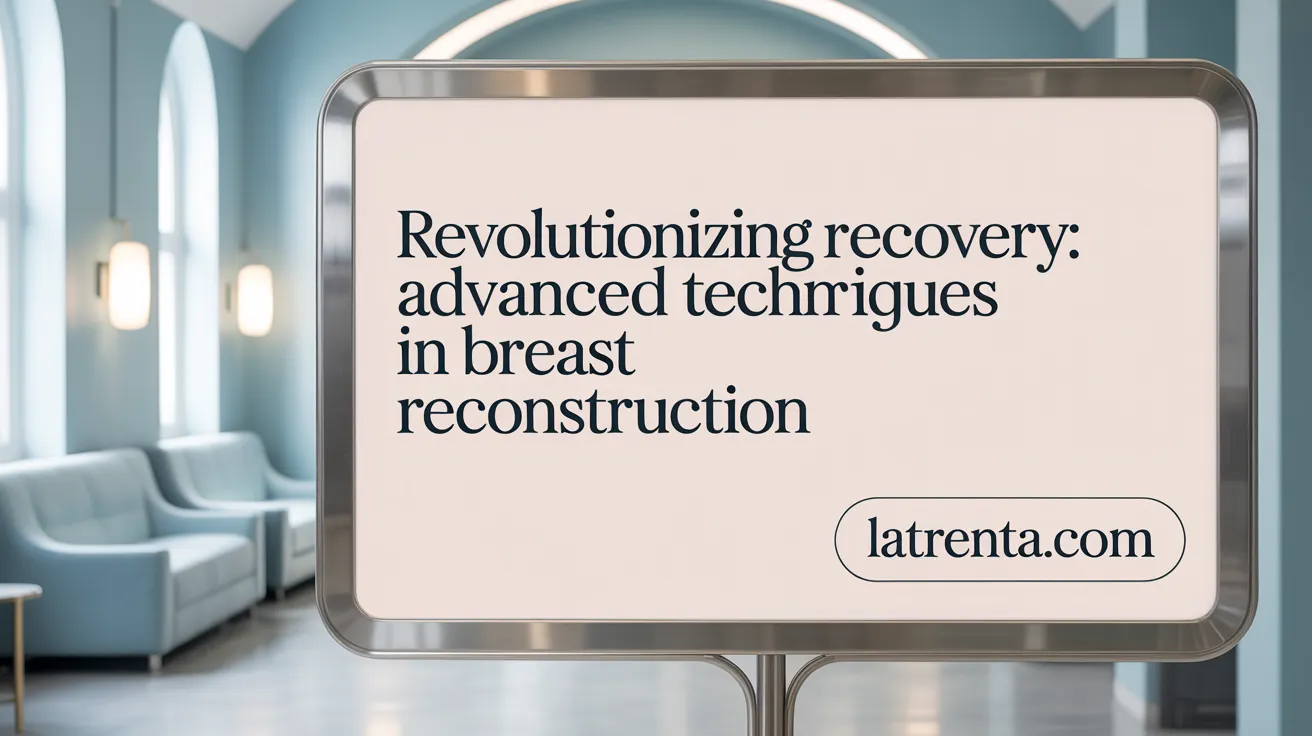Introduction to Modern Breast Surgery Innovations
Evolving Techniques in Breast Surgery
Breast surgery has undergone significant innovation aimed at enhancing natural aesthetics and improving patient outcomes. Contemporary procedures emphasize restoring and augmenting breast shape with a focus on safety, natural feel, and patient-centered care.
Embracing Advanced Technologies
Cutting-edge implant designs, such as fifth and sixth-generation silicone implants with thin, flexible shells, offer improved natural texture and durability. Surgical adjuncts like dissolvable mesh scaffolds provide soft tissue support to prevent common complications including implant shifting and capsular contracture.
Personalized and Holistic Patient Care
Surgeons now combine breast lifts with implants and fat grafting to tailor procedures to individual anatomy and aesthetic goals, achieving better volume distribution and contour. Minimally invasive insertion techniques reduce trauma and expedite recovery. Moreover, these advancements collectively enhance both physical and psychosocial well-being by boosting confidence and body harmony.
By integrating innovation with personalized treatment plans, modern breast surgery prioritizes natural appearance and patient satisfaction, representing a transformative shift in aesthetic breast care.
Advancements in Breast Implant Technology and Surgical Methods

How Have Breast Implants Evolved in Recent Generations?
Breast implant technology has advanced significantly, now reaching the 5th and 6th generation implants. These latest implants feature thinner, more flexible shells combined with highly cohesive silicone gel. This innovation enhances the natural feel breast implants look of the breast, providing safe breast augmentation methods and a more comfortable patient experience compared to earlier models.
What Are the Latest Innovations in Implant Materials and Design?
Recent FDA-approved breast implants such as Motiva® breast implants Ergonomix® represent cutting-edge plastic surgery techniques. These implants mimic natural breast movement and incorporate a smooth shell implant design to minimize complications like capsular contracture prevention. Additionally, some implants now include safety technology like the Q Inside® Safety Technology chip, enabling easy implant identification and enhancing patient safety.
Which Surgical Techniques Have Improved Implant Placement and Recovery?
The Keller Funnel® surgical technique exemplifies innovation in surgical methods, enabling minimally invasive implant insertion. This reduces tissue trauma and results in smaller scars, promoting faster breast augmentation recovery. Moreover, the introduction of dissolvable mesh scaffolds in breast augmentation—often referred to as internal bra breast support—provides temporary breast tissue support to breast tissue. This approach reduces risks such as reducing implant shifting complications and capsular contracture prevention, especially when combined with implant placement above muscle.
How Is Fat Grafting Combined With Implants to Enhance Outcomes?
A trend toward more natural-looking breast implants has fostered combining fat grafting with implants. Fat transfer with implants complements the volume restoration provided by implants and improves breast contour and upper pole fullness. This hybrid approach allows for precise sculpting and personalization, addressing anatomical limitations in breast surgery and creating a more harmonious breast appearance.
What Are the Benefits of These New Breast Implant Technologies and Techniques?
These advancements collectively contribute to enhanced patient safety in plastic surgery, improved natural aesthetics, and greater customizable breast augmentation options. They also facilitate faster recovery times due to less invasive surgical techniques and reduced tissue trauma. Patients benefit from a wider array of choices tailored to their unique anatomy and aesthetic goals, resulting in more satisfying and lasting outcomes.
Enhancing Breast Lift and Shape Through Combined Procedures

Role of mastopexy (breast lift) in correcting ptosis and sagging
A mastopexy, commonly known as a breast lift, is a surgical technique designed to reposition and reshape the breast tissue. It effectively addresses breast sagging (ptosis) caused by factors such as gravity, aging, pregnancy, or weight fluctuations. By removing excess skin and lifting the breast mound, mastopexy restores a firmer, perkier breast contour.
Combining breast lift with augmentation implants for volume and shape
Combining a breast lift with augmentation using implants is often performed as a single-stage procedure, providing both lift and volume enhancement. This combined approach benefits patients with ptotic breasts and insufficient upper pole fullness by simultaneously correcting sagging and improving breast shape. It offers advantages such as reduced anesthesia exposure, lower overall cost, and streamlined recovery compared to staged surgeries. Learn more about the benefits of breast lift combined with augmentation.
Use of fat grafting to enhance upper pole fullness and precise contouring
Fat grafting represents a sophisticated option to complement breast lifts or implants. By harvesting and transferring the patient’s own fat to the breast, surgeons can refine shape, increase upper pole projection, and smooth contours with exceptional precision. With approximately 70% fat graft survival, this technique promotes a natural appearance and can also address challenging anatomy where implants alone might be insufficient. Techniques combining fat grafting with implants offer personalized cosmetic surgery care.
Anatomical considerations influencing procedure choice
Anatomical factors play a pivotal role in planning breast rejuvenation procedures. Features such as a wide sternum, sloping chest walls, or a long chest with a low breast fold may limit the outcomes achievable with implants alone. In these scenarios, fat grafting or a combined lift and implant approach allows for tailored correction that respects individual body structure.
Single-stage procedures reducing recovery and improving outcomes
Performing breast lift combined with augmentation implants or fat grafting in a single surgery enhances patient experience by minimizing recovery time and anesthesia risks. It also simplifies postoperative care, accelerates the return to daily activities, and often results in superior aesthetic harmony owing to simultaneous tissue repositioning and volume restoration. This approach is supported by advanced breast augmentation techniques.
Patient-centered planning for natural, youthful breast profile
A customized approach is essential, focusing on patients’ aesthetic goals and physical needs to achieve natural and youthful results. Expert surgeons assess breast volume, skin quality, nipple position, and overall body proportions to recommend optimal combinations of mastopexy, implants, and fat grafting. This patient-centered methodology ensures a harmonious, tailored breast profile with long-lasting satisfaction.
Innovations in Breast Reconstruction Post-Mastectomy

What are the primary methods for breast reconstruction after mastectomy?
Breast reconstruction after mastectomy is primarily accomplished through two methods: implant-based reconstruction and autologous flap reconstruction. Implant-based reconstruction uses silicone or saline implants to recreate breast shape. Often, this method involves tissue expanders to prepare the chest for implant placement. Autologous reconstruction, sometimes called flap reconstruction, uses the patient’s own tissue—commonly from the abdomen (e.g., DIEP flap breast reconstruction), back, or thighs—to rebuild a natural breast mound.
How have flap procedures advanced in recent years?
Recent advances have refined flap surgery techniques, especially with the DIEP flap breast reconstruction, which transplants skin and fat from the lower belly without sacrificing muscle, leading to less donor-site morbidity and better functional outcomes. Hybrid reconstructions combining flap tissue with implants allow tailored volume and shape customization. These innovations improve symmetry, enhance natural aesthetics, and offer durable, lifetime results.
What is oncoplastic surgery and how does it benefit reconstruction?
Oncoplastic surgery integrates oncologic cancer removal with plastic surgical techniques, enabling wider tumor excision while maintaining or even improving breast aesthetics. It is especially valuable for larger or multifocal tumors, and combines resection with tissue rearrangement, lifts, or reductions to optimize contour. This approach minimizes the need for multiple surgeries and enhances post-treatment symmetry and patient satisfaction.
How do nerve grafting techniques improve sensation after reconstruction?
Emerging sensory restoration techniques involve nerve grafts during flap reconstruction or implant surgery, aiming to reconnect nerves and promote sensory return. While full pre-mastectomy sensation may not always be restored, many patients experience improved light touch perception over time. This innovation enhances the functional and emotional aspects of breast reconstruction, including advances like Resensation® nerve grafting.
What are the considerations regarding timing: immediate versus delayed reconstruction?
Breast reconstruction can be performed immediately during mastectomy surgery or delayed until after cancer treatment and recovery. Immediate reconstruction offers psychological benefits and fewer surgeries but may be influenced by planned radiation therapy. Delayed reconstruction allows for treatment flexibility and optimized surgical planning. Both options are personalized to meet individual medical needs and preferences. Details on immediate vs delayed breast reconstruction provide insights into timing considerations.
In what ways does breast reconstruction impact quality of life and self-image?
Breast reconstruction significantly improves body image, promotes self-esteem, and restores a sense of wholeness for many women post-mastectomy. It enhances physical symmetry and clothing fit, which contributes to confidence in social and intimate settings. This psychological benefit translates to improved emotional wellbeing and quality of life, underscoring the importance of breast reconstruction and quality of life.
Breast Cancer Surgery and Oncoplastic Techniques Improving Outcomes

Advances in Breast Cancer Detection and Minimally Invasive Surgery
Early detection remains paramount in breast cancer treatment, with technological advances such as Digital mammography and 3D tomosynthesis and Contrast-enhanced digital mammography vastly improving diagnostic accuracy, especially in dense breast tissue. These imaging tools enable clinicians to identify suspicious lesions earlier, facilitating less invasive surgeries that conserve breast tissue while effectively managing cancer.
Role of Oncoplastic Surgery in Wider Tumor Excision with Cosmetic Benefit
Oncoplastic Breast Surgery uniquely combines oncologic and plastic surgery techniques, allowing for the removal of larger or multifocal tumors with adequate margins while preserving, or even enhancing, breast aesthetics. This integration supports wider tumor excisions which traditionally risked significant cosmetic deformity.
Tailored Treatment Based on Tumor Subtype and Patient Anatomy
Treatment approaches are increasingly personalized according to tumor biology—such as Hormone receptor-positive breast cancer, HER2-positive breast cancer, or Triple-negative breast cancer subtypes—and individual patient anatomy. This tailoring improves therapeutic effectiveness and reconstructive outcomes, ensuring oncologic safety alongside patient-specific cosmetic goals.
Enhanced Aesthetic Results and Reduced Re-Excision Rates with Oncoplastic Methods
Oncoplastic surgery has demonstrated benefits including Lower positive margin rates, resulting in fewer re-excision surgeries. By employing a variety of tissue rearrangement techniques—from local reshaping for small defects to lifts or flap procedures for larger resections—patients achieve improved breast symmetry and contour.
Integration of Multidisciplinary Teams to Optimize Cancer Treatment and Breast Appearance
Successful oncoplastic surgery relies on collaborative teams of breast surgeons, plastic surgeons, radiologists, and oncologists. This multidisciplinary coordination ensures comprehensive care that simultaneously targets disease eradication and aesthetic preservation, enhancing overall patient satisfaction and quality of life.
Quality of Life Improvements and Patient-Centered Care in Breast Surgery
How does breast surgery enhance physical comfort and emotional well-being?
Breast surgery offers significant physical and emotional benefits. Reduction procedures can alleviate chronic pain in the back, neck, and shoulders caused by large breasts, improving posture and overall body balance improvement. Augmentation and reconstructive surgeries restore breast volume and shape, enhancing self-image and body symmetry. Patients often experience boosted self-esteem and confidence, which positively impacts social interactions, romantic relationships, and workplace performance.
Why is a personalized approach critical in breast surgery?
Successful breast surgery hinges on individualized treatment plans that address each patient’s unique anatomy and aesthetic goals. Board-certified plastic surgeons specialize in combining patient safety with natural-looking, harmonious outcomes. Techniques such as fat grafting for breast enhancement, combining lifts with implants, and using dissolvable mesh scaffolds in breast augmentation exemplify the personalized and innovative solutions available. Surgeons carefully tailor procedures to avoid anatomical limitations and optimize comfort and appearance.
What role do emerging technologies play in improving breast surgery outcomes?
Advancements in Motiva® breast implants Ergonomix®, like the highly cohesive silicone gel in latest-generation implants, and surgical tools such as the Keller Funnel® surgical technique reduce trauma and accelerate recovery. Technologies supporting nerve repair during reconstruction improve sensation preservation, contributing to long-term satisfaction. Minimally invasive expansions and refined internal support systems allow for faster healing, reduced complications, and more customizable options, enhancing both physical outcomes and patient experience.
How do breast surgery procedures contribute to long-term psychological benefits?
Beyond physical restoration, breast surgeries substantially elevate mental health by improving breast surgery benefits including boosted self-esteem and confidence and reducing anxiety related to appearance. Breast reconstruction after mastectomy not only restores the breast’s look but also fosters renewed self-worth. Patients report increased feelings of happiness and a better overall quality of life that extend well beyond the immediate postoperative period, emphasizing the psychological importance of comprehensive, patient-centered care.
